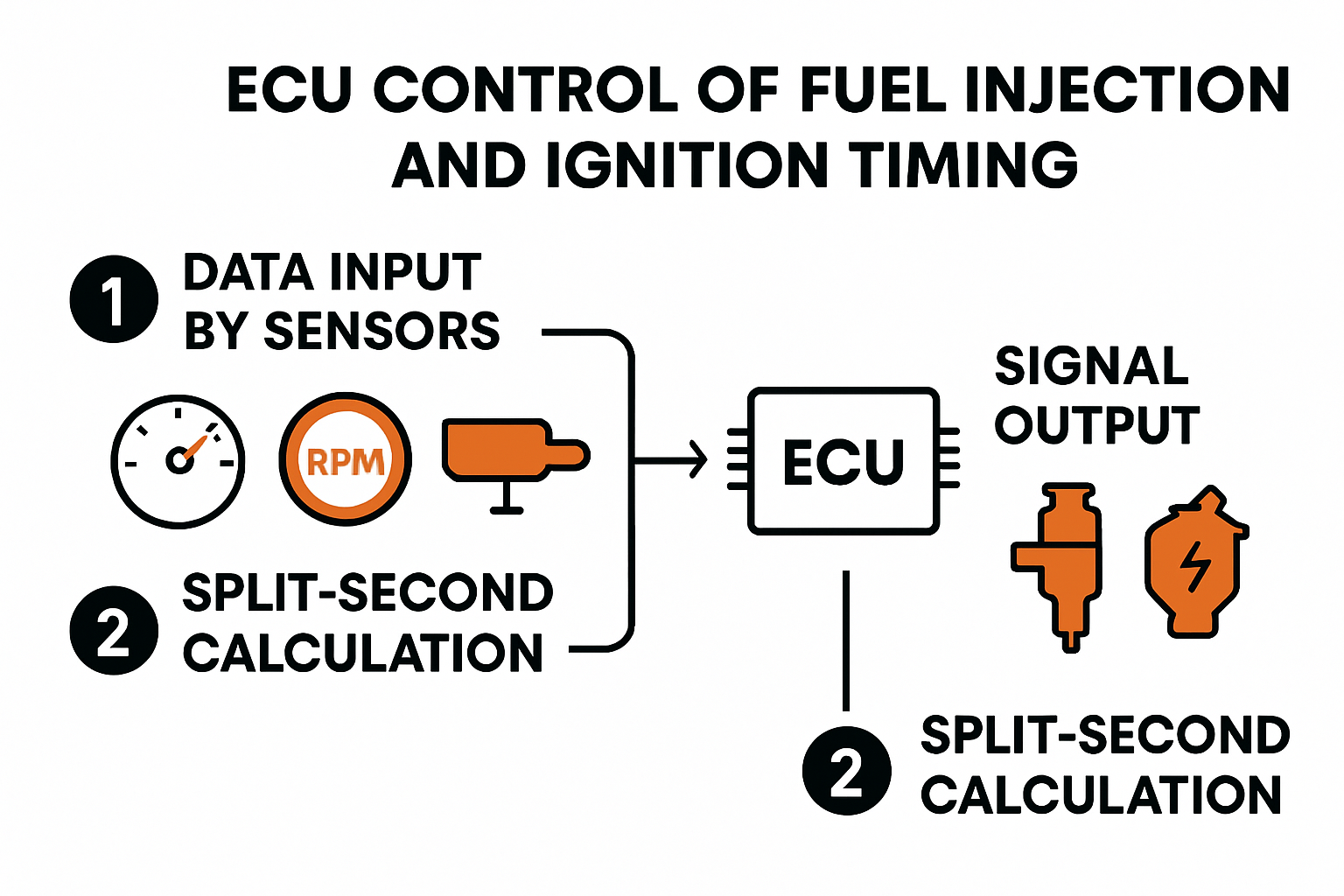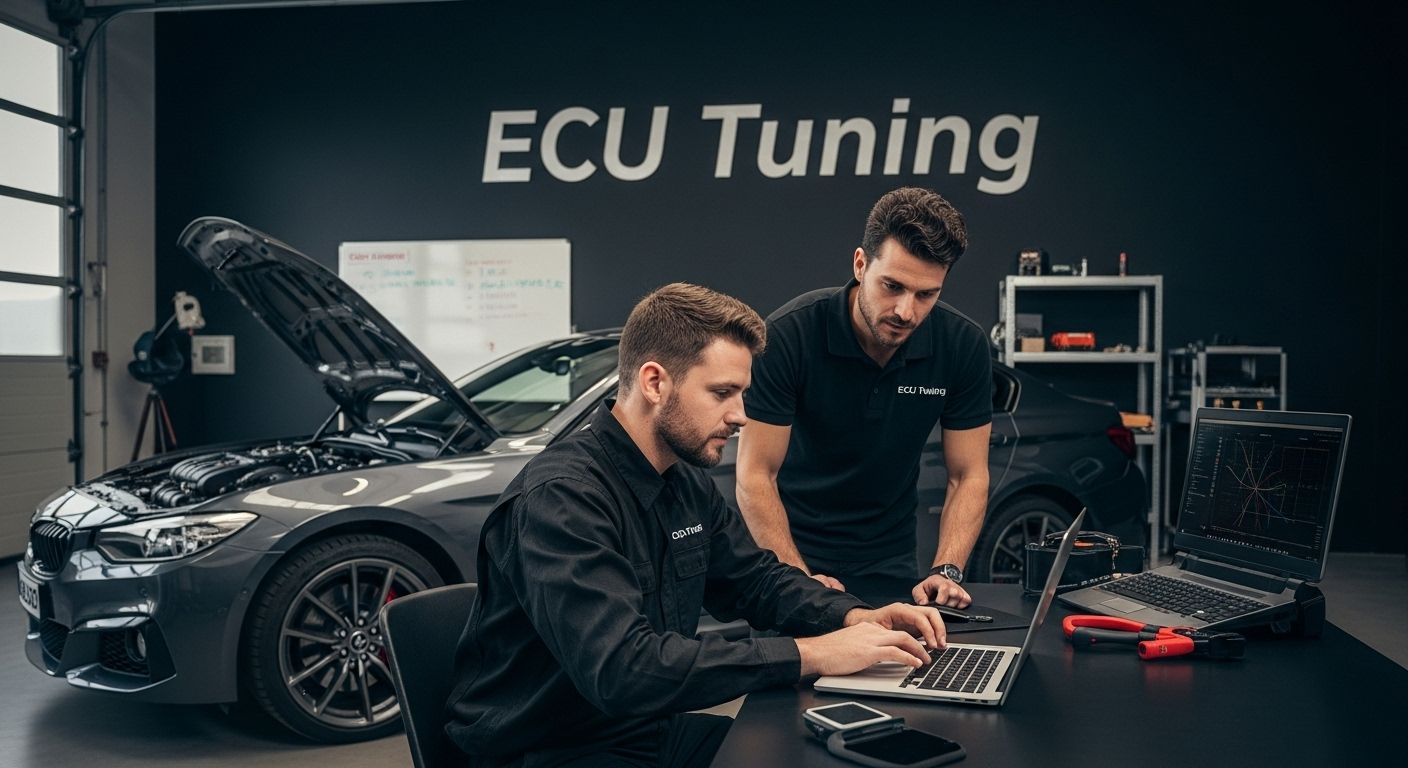The ECU is known as the brain of your car for a reason and modern vehicles rely on this hidden microprocessor for far more than you might expect. Most people focus on horsepower or fuel economy, but the ECU actually makes thousands of real-time calculations every single second to manage everything from fuel injection to emissions. What surprises a lot of drivers is that today’s ECUs can even learn from your habits and adapt for better performance as you drive—turning every commute into a personalized experience.
Table of Contents
- Ecu Basics And Main Functions
- Sensors And Inputs The Ecu Monitors
- How Ecu Controls Engine Performance
- Advanced Ecu Tuning And Customization
Quick Summary
| Takeaway | Explanation |
|---|---|
| ECUs are the brain of modern cars | The ECU manages complex engine operations, optimizing performance and emissions through real-time calculations. |
| Sensor data drives engine optimization | The ECU processes inputs from various sensors to adjust fuel injection and ignition timing for better efficiency. |
| ECUs can adapt to driving conditions | Modern ECUs learn from driver behavior and mechanical changes to maintain optimal engine performance over time. |
| Advanced tuning enhances vehicle performance | Techniques like adaptive mapping and machine learning enable precise adjustments to maximize engine output and efficiency. |
| Emerging technologies revolutionize ECU tuning | Incorporating AI allows for continuous adaptation and real-time diagnostics, paving the way for smarter vehicle performance enhancements. |
ECU Basics and Main Functions
The Engine Control Unit (ECU) serves as the critical brain of modern automotive systems, managing complex engine operations with remarkable precision. Understanding ECU fundamentals reveals a sophisticated electronic system that transforms raw sensor data into optimal engine performance.
Core Electronic Management System
At its essence, an ECU is a dedicated microprocessor designed to monitor and regulate multiple engine subsystems simultaneously. According to automotive engineering research, the ECU continuously processes information from numerous sensors positioned throughout the vehicle. These sensors capture critical data points including engine temperature, air intake volume, throttle position, crankshaft rotation speed, and exhaust gas composition.
The ECU’s primary function involves making real-time calculations that optimize engine performance, fuel efficiency, and emissions control. By analyzing incoming sensor data within milliseconds, the system can adjust fuel injection timing, ignition sequences, and air-fuel mixture ratios to ensure maximum operational efficiency.
Sensor Integration and Decision Making
Modern ECUs utilize an intricate network of sensors that act as the vehicle’s sensory system. Key sensors include:
- Accelerator Pedal Position Sensor: Monitors driver input and throttle engagement
- Crankshaft Position Sensor: Tracks engine rotation and synchronization
- Oxygen Sensor: Measures exhaust gas composition for precise fuel management
- Coolant Temperature Sensor: Monitors engine thermal conditions
These sensors transmit continuous data streams to the ECU, which processes information through complex algorithmic models. Automotive electronics research indicates that modern ECUs can make thousands of computational adjustments per second, ensuring optimal engine performance across varying driving conditions.
Performance and Adaptation Capabilities
Beyond basic management, contemporary ECUs demonstrate remarkable adaptive capabilities. They can learn and adjust to changing mechanical conditions, compensating for wear, environmental shifts, and individual driving patterns. This dynamic calibration ensures consistent engine performance and longevity.
The ECU’s computational power extends beyond immediate engine management. It communicates with other vehicle control systems, integrating data from transmission control units, anti-lock braking systems, and electronic stability controls to provide comprehensive vehicular performance optimization.
For automotive enthusiasts seeking deeper insights into ECU technologies and advanced tuning strategies, understanding these fundamental operational principles provides a critical foundation for performance enhancement and precision engineering.
Sensors and Inputs the ECU Monitors
The Electronic Control Unit (ECU) relies on an extensive network of sensors to gather critical information about the vehicle’s operating conditions. Research from automotive engineering experts reveals a complex ecosystem of sensors that provide real-time data essential for optimal engine performance and efficiency.
Critical Sensor Types and Their Functions
Modern vehicles incorporate multiple sensors that serve as the ECU’s sensory system. According to Monolithic Power Systems research, these sensors can be categorized into several key groups:
- Temperature Sensors: Monitor critical temperatures including engine coolant, oil, and intake air. These sensors help prevent overheating and ensure optimal thermal management.
- Pressure Sensors: Track fuel pressure, oil pressure, and manifold air pressure, providing crucial data for fuel delivery and engine load calculations.
- Position Sensors: Include crankshaft and camshaft position sensors that track engine rotation and timing with remarkable precision.
Below is a table summarizing the main types of ECU sensors and their primary functions, aiding in quick reference for readers:
| Sensor Type | Example Sensors | Primary Function |
|---|---|---|
| Temperature Sensors | Coolant Temperature, Oil Temperature, Intake Air | Monitor engine and fluid temperatures |
| Pressure Sensors | Fuel Pressure, Oil Pressure, MAP Sensor | Track system pressures for engine control |
| Position Sensors | Crankshaft, Camshaft | Measure rotation/position for timing and sync |
| Oxygen Sensor | Oxygen (O2) Sensor | Analyze exhaust gases for fuel/air adjustment |
| Mass Airflow Sensor | MAF Sensor | Measure intake air volume and density |
| Throttle Position Sensor | Throttle Position Sensor | Monitor accelerator/throttle engagement |
| Knock Sensor | Knock Sensor | Detect engine knock or detonation |
Advanced Sensor Data Processing
Automotive diagnostic research demonstrates the sophisticated way ECUs interpret sensor inputs. The system continuously analyzes data from multiple sensors simultaneously, making thousands of calculations per second. Key sensors play critical roles:
- Oxygen Sensor: Monitors exhaust gas composition to optimize fuel-air mixture
- Mass Airflow Sensor: Measures incoming air volume and density
- Throttle Position Sensor: Tracks accelerator pedal input and engine load
- Knock Sensor: Detects potential engine detonation or pre-ignition
These sensors work in concert to provide a comprehensive view of the engine’s operational status. For professionals interested in advanced ECU file management and performance tuning, understanding these sensor inputs is crucial for precise engine optimization.
The sensor network goes beyond simple data collection. Modern ECUs use machine learning algorithms to interpret sensor data, adapting to changing driving conditions, vehicle age, and individual performance characteristics. This adaptive approach ensures consistent engine performance, improved fuel efficiency, and reduced emissions.
By continuously monitoring and processing sensor inputs, the ECU acts as a sophisticated guardian of vehicle performance, making split-second decisions that optimize engine operation across diverse driving scenarios. The intricate dance of sensors and computational algorithms represents the pinnacle of automotive electronic engineering, transforming raw data into intelligent vehicle management.
How ECU Controls Engine Performance
The Electronic Control Unit (ECU) serves as the sophisticated command center for managing engine performance, transforming raw mechanical potential into precise, optimized power delivery. According to automotive engineering research, the ECU employs a complex network of computational strategies to regulate and enhance vehicle performance.
A summary table below illustrates key ECU-controlled engine functions and the performance benefits provided. This helps to clearly connect specific ECU actions to their outcomes.
| ECU-Controlled Function | Example Actions | Performance Benefit |
|---|---|---|
| Fuel Injection | Adjust timing/amount for each cylinder | Improved combustion & efficiency |
| Ignition Timing | Control spark advance/retard | Enhanced power, reduced emissions |
| Air-Fuel Mixture | Dynamic ratio adjustment | Optimal power & fuel economy |
| Throttle Control | Electronic actuator modulation | Responsive acceleration & smoother ride |
| Adaptive Learning | Ongoing parameter adjustment | Consistent performance over vehicle life |
| Real-Time Diagnostics | Error/fault detection/response | Early issue detection and correction |
Fuel Injection and Ignition Precision
At the core of engine performance control, the ECU manages fuel injection and ignition timing with remarkable accuracy. Wikipedia’s automotive technology overview highlights how the ECU processes sensor data to determine the exact moment and quantity of fuel injection. This precision ensures optimal combustion efficiency, balancing power output with fuel economy.
The system continuously calculates the ideal air-fuel mixture based on multiple parameters including:

- Engine Load: Determines fuel requirements at different performance levels
- Ambient Temperature: Adjusts fuel mixture for environmental conditions
- Throttle Position: Matches fuel delivery to driver’s acceleration input
- Engine RPM: Synchronizes fuel injection with engine rotation speed
Electronic Throttle Control Dynamics
Electronic throttle control research reveals a revolutionary approach to engine power management. Unlike traditional mechanical systems, the ECU now directly controls the throttle valve through electronic actuators. This technology provides unprecedented precision in power delivery, allowing instantaneous adjustments that dramatically improve vehicle responsiveness.
The electronic throttle system enables advanced performance features such as:
- Adaptive cruise control integration
- Precise power output management
- Enhanced fuel efficiency
- Improved emissions control
Performance Optimization and Adaptive Learning
Modern ECUs go beyond simple mechanical control, implementing sophisticated adaptive learning algorithms. These systems continuously analyze driving patterns, environmental conditions, and vehicle performance to make real-time adjustments. For automotive enthusiasts interested in advanced performance tuning strategies, understanding these adaptive capabilities is crucial.
The ECU’s performance optimization involves complex computational processes that:
- Monitor engine health
- Predict potential mechanical issues
- Adjust performance parameters dynamically
- Maintain optimal efficiency across diverse driving conditions
This intelligent approach transforms the ECU from a simple control module into a comprehensive performance management system. By integrating advanced sensor data, computational algorithms, and real-time adaptive learning, the ECU represents the pinnacle of automotive electronic engineering. Professional tuners and automotive enthusiasts recognize this technology as a critical pathway to unlocking a vehicle’s true performance potential.
Advanced ECU Tuning and Customization
Advanced ECU tuning represents a sophisticated approach to unlocking a vehicle’s maximum performance potential, transforming standard factory settings into precision-engineered mechanical excellence. Research from automotive optimization studies reveals complex methodologies that push the boundaries of electronic vehicle management.
Optimization Techniques and Computational Strategies
Professional ECU tuning involves intricate computational techniques that go far beyond simple parameter adjustments. Bayesian optimization research demonstrates advanced methods for refining electronic control systems with unprecedented precision.
Key optimization strategies include:
- Adaptive Parameter Mapping: Dynamically adjusting performance parameters based on real-time driving conditions
- Machine Learning Algorithms: Implementing neural network techniques to predict and optimize engine performance
- Predictive Computational Modeling: Using sophisticated algorithms to simulate potential performance outcomes
Performance Mapping and Customization
Modern ECU tuning transcends traditional mechanical adjustments, introducing a new era of electronic performance engineering. Advanced computational techniques allow for granular control over multiple engine subsystems, enabling unprecedented levels of customization.
Professional tuners can now modify critical performance parameters such as:
- Fuel injection timing
- Boost pressure in turbocharged engines
- Ignition advance and retard characteristics
- Throttle response curves
- Rev limit adjustments
For enthusiasts seeking comprehensive performance file solutions, understanding these advanced tuning methodologies provides a critical foundation for vehicle optimization.
Emerging Technologies in ECU Customization
Cutting-edge ECU tuning now incorporates artificial intelligence and machine learning technologies that fundamentally transform vehicle performance optimization. These advanced systems can:
- Learn from individual driving patterns
- Continuously adapt to changing mechanical conditions
- Predict potential performance improvements
- Provide real-time performance diagnostics
Below is a summary table highlighting traditional ECU tuning solutions versus emerging AI-driven tuning technologies explained in this section. This comparison clarifies how modern advancements are transforming customization options:
| Tuning Approach | Methods Used | Customization Level | Adaptability |
|---|---|---|---|
| Traditional Tuning | Manual parameter alteration | Fixed or preset | Limited |
| Advanced Tuning | Computational mapping, ML algorithms | Granular, precise | Moderately adaptive |
| AI-Driven Tuning | Machine learning, real-time adjustment | Highly personalized, dynamic | Continuously adaptive |
The future of ECU tuning lies in creating intelligent, adaptive systems that move beyond static performance mapping. By integrating advanced computational techniques, machine learning algorithms, and precision electronic control, automotive engineers and performance enthusiasts can unlock levels of vehicle performance previously considered impossible.
This technological evolution represents more than mere mechanical enhancement. It symbolizes a profound shift in how we understand and interact with automotive performance technology, transforming vehicles from static mechanical systems into dynamic, intelligent platforms capable of continuous self-optimization.

Frequently Asked Questions
What is the role of the ECU in a vehicle?
The Engine Control Unit (ECU) acts as the brain of the vehicle, managing and optimizing engine performance, fuel efficiency, and emissions by processing data from various sensors in real time.
How does the ECU adapt to my driving habits?
Modern ECUs utilize adaptive learning algorithms to monitor and analyze your driving patterns and mechanical conditions, allowing them to make real-time adjustments for optimal engine performance.
What types of sensors does the ECU use to monitor engine performance?
The ECU integrates multiple essential sensors, including temperature sensors, pressure sensors, position sensors, and oxygen sensors, which provide continuous data to support efficient engine management.
Can I tune my ECU for better performance?
Yes, advanced ECU tuning techniques allow for optimized performance by modifying fuel injection timing, ignition settings, and throttle response. Cutting-edge technologies like machine learning can also enhance tuning processes for greater adaptability.
Unlock Precision ECU Solutions for Every Performance Challenge
If you have read about how modern ECUs adapt, learn, and control engine performance in seconds, you might feel excited about new possibilities for your car. But maybe you run into barriers that keep your vehicle from reaching its true potential. Factory limitations, old calibration files, or missing data can block upgrades, tuning, or even recovery after an ECU failure. When maximum efficiency, reliable performance, and safe engine management matter most, you deserve solutions that go beyond generic advice.

Visit ECUFlashFiles.com to access a proven catalog of tested ECU files and tuning tools. Use the advanced search to find original or performance tuning files matched to your make, model, and hardware version. Explore how our professional file management can support ECU remapping, secure data recovery, or upgrades tailored to your driving goals. Do not let technical roadblocks hold you back. Get instant access to trusted, performance-ready ECU solutions and transform what you learned today into real results for your car.
Recommended
- ECU Tuned File | stage 1 | Yamaha GP Mitsubishi Undefined EG815-59051F7070X19 EH009-69952
- ECU Tuned File | stage 1 | VW Transporter Bosch EDC17CP20 EDC17 CB.03.15.00 C34.00 1.0 03L906022CD
- ECU Tuned File | stage 1 | VW Transporter Bosch EDC17CP20 EDC17 CB.03.15.00 C34.00 1.0 03L906022JD
- ECU Tuned File | stage 1 | VW Transporter Siemens/Continental EDC17CP20 03L907309M 03L906019GG
